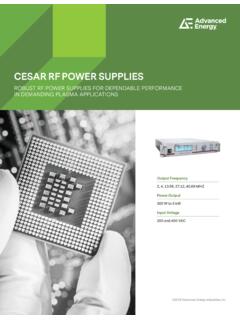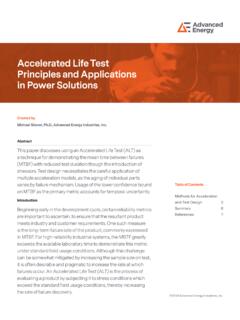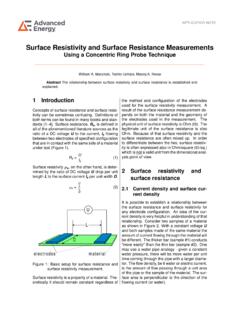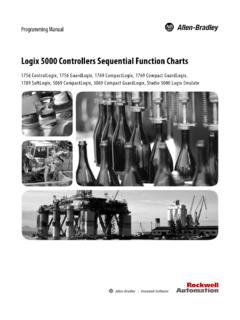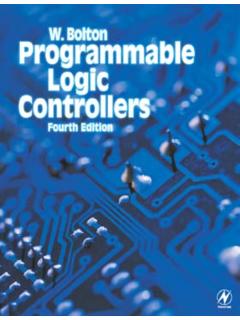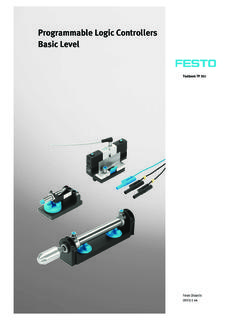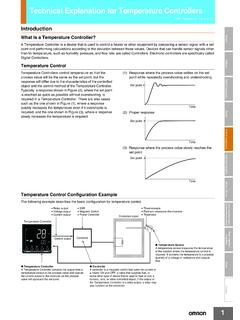Transcription of What You Need to Know About SCR Power Controllers
1 ABSTRACTT emperature regulation is required in nearly every manufacturing process, typically for the purposes of material heating, melting, drying, or forming. SCR Power Controllers , also called silicon controlled rectifiers (SCRs), play a critical role in temperature regulation. Their primary use is to control the flow of electricity from the grid to a heater. This function precisely regulates temperature to produce specific material effects or properties within an industrial furnace, oven, or other thermal processing equipment. Compared to alternative devices, such as IGBT-based Controllers , SCR Power Controllers provide much greater efficiency up to SCR Power Controllers also are used to replace contactors or relays due to the wear-free switching offered by thyristor devices. This characteristic greatly improves reliability and product YOU NEED TO know About SCR Power CONTROLLERSFUNCTIONS, FEATURES, AND EFFICIENCIES TABLE OF CONTENTSA bstract1 FunctionalityKey Features for SCR-Based 3 Thermal ProcessingEconomic Efficiency 5 Energy Efficiency 7 Conclusion7 FUNCTIONALITYF igure 2.
2 Operation of a Power controller module in an industrial heating applicationFigure 2 shows a closed-loop system in which the SCR Power controller regulates the flow of Power from the mains to a furnace, oven, or heater. The temperature sensor or transmitter located within the furnace sends a direct feedback signal to either a Rockwell Automation Logix controller or external temperature controller . The Rockwell Automation Logix controller or temperature controller then transmits an analog or digital set point to the SCR Power controller . This set point is based on the chamber temperature, control, and PID settings. The SCR Power controller uses this set point to regulate the flow of electricity to the heater and achieve a precise, stable temperature inside the furnace. A high-quality SCR Power controller can regulate current, voltage, or Power output, depending on process requirements and conditions.
3 Page 2 Page 3 KEY FEATURES FOR SCR-BASED THERMAL PROCESSINGSCR Power Controllers play a critical role in nearly every industrial manufacturing process that uses electrical heating. Typical industries include: Chemical Industrial furnace Glass and crystal Metals Oil and gasSCR Power Controllers ensure high quality and cost efficiency through their high accuracy, flexibility, small footprint, and energy AND REPEATABILITYV ariations in mains voltage and heating-element resistance are common issues that impair the accuracy of temperature regulation. The mains voltage can vary up to and even beyond 10%, resulting in temperature fluctuations. SCR Power Controllers compensate for mains voltage fluctuations by employing RMS voltage regulation. An SCR s voltage regulation mode adjusts the firing angle (phase angle) or duty cycle (zero cross) of the SCR output to maintain a constant voltage output proportional to the set point.
4 Variations in heating-element resistance are due to aging, temperature coefficients, and/or other materials characteristics. SCR Power Controllers can compensate for these variations by regulating the RMS output current. When both true RMS current and true RMS voltage regulation are employed, the SCR Power controller is said to be in Power regulation mode. Power regulation allows the SCR Power controller to regulate true Power independent of variations in the mains voltage or heater resistance. Power regulation is the most accurate means of regulating temperature and promotes the highest level of process AND FLEXIBILITYSCR Power Controllers that provide a wide range of operation modes and communication options enable optimal performance and easy integration into any process. For systems with Rockwell Automation Logix Controllers using digital set points to communicate with the SCR Power controller , typical field bus protocols include: Ethernet/IP DeviceNet Profibus DPV1 PROFINET Modbus TCP Modbus RTU CANopen In particular, Ethernet/IP -connected SCR Power Controllers enable system streamlining, with fewer components and advanced data collection.
5 Reduction of cable and communication card count lowers cost and reduces potential points of failure. Shorter cable length also augments efficiency for reduced Power Power Controllers must be small in order to fit the tight quarters of industrial manufacturing systems. The most advanced SCR Power Controllers offer a small footprint without sacrificing functionality. ENERGY EFFICIENCYBoth the public and industrial sectors have seen a dramatic increase in energy costs in recent years. The latest production technologies offer high efficiency to reduce overall capital and operating expenditures, especially in energy-intensive applications. At efficiency, SCR Power Controllers offer a distinct advantage over alternative devices such as IGBT-based Power supplies and converters. Furthermore, modern SCR Power Controllers offer multiple firing modes, enabling users to select the best control method for their application.
6 Firing modes can be selected based on technical requirements, such as minimizing THD or maximizing Power resolution. Advanced control methodologies such as mains load optimization can be used to reduce peak load demand of multiple SCR units, resulting in lower energy rates. Page 4 Phase-angle (VAR) mode is very commonly used in heat applications due to its precise resolution of Power . However, phase-angle mode is also known for generating excessive harmonics and low Power factor, and in some cases can directly interfere with the operation of other equipment. Digital SCR Power Controllers with advanced features may offer the following alternatives:Normalized Output PowerTHDi in % mode (VAR)VT/VSC modeZero-cross mode (TAKT) Figure 3. THDi reduction with VT, VSC, and TAKT firing modes Zero-cross mode (TAKT) is a full-wave switching operation mode that creates virtually no harmonics and is standard in many heating applications.
7 The ability to cut the first half-wave also enables this mode to drive transformer-coupled loads while minimizing inrush current. For multiple-zone applications operating in zero-cross mode, automatic digital mains load optimization (dASM) reduces peak load demand and THDi. Voltage sequence control (VSC), the autotap operating mode, provides phase-angle mode s fast response, high control dynamic, and high control resolution per cycle without the disadvantages of harmonics and noise. This mode is used for single or multiple tranformer-coupled heating zones. VT mode combines zero-cross and phase-angle firing, and is frequently used for applications with low thermal inertia, such as infrared and single-phase applications, that are not transformer-coupled. VT mode makes use of the advantages of both zero-cross and phase-angle modes, and, in addition, provides mains load optimization (SVT) for multiple-zone applications.
8 MoSi mode is used for heating resistors with very low cold resistance and high thermal inertia. It delivers the advantages of zero-cross mode to applications that require pre-heating in phase-angle firing for each production cycle. In applications with high hot/cold resistance ratios, the SCR Power controller can automatically ramp up to the required temperature in phase-angle mode and then switch automatically to zero-cross mode to maintain that 5 ECONOMIC EFFICIENCYSCR Power controller connectivity options and energy efficiency provide many opportunities to reduce CONNECTIVITY OPTIONSSCR Power Controllers expand the potential for cost savings by offering a comprehensive range of connectivity options. For example, Ethernet/IP connectivity can reduce component count, enabling the use of fewer cables and communication cards.
9 This translates into significant savings: E thernet/IP eliminatesunnecessary analogequipment and example, most SCRpower control moduleshave built-in current andvoltage transformers. Thismakes the requirementfor external equipment such as voltmeters unnecessary. Instead,current and voltageparameters can besent directly to an HMI,Rockwell Automation Logixcontroller, or Panel Viewscreen. Further, multipleheating zones can bemonitored, configured,and/or controlled by asingle access point. E thernet/IP provides ahigher level of digitalcontrol, resulting ingreater accuracy andhigher reliability for your industrial heat process. Increased uptime and higher yield are also likely benefits. In addition, the Ethernet/IP connectivity allows easy integration with other control interfaces streamlining the development process.
10 Replacement of obsoleteanalog SCR units withadvanced digital SCRunits provides a low-costoption for enhancingimmediate performanceand functionality, withthe option of upgradingto higher-level buscommunications/control systems at alater time. Applicationswith previously nocommunication optionscan be easily upgradedto include Ethernet/IP (or other communications) with the addition of a bus module. This gives your original design new life with greater functionality that can be expanded when you are ready to move in that network card solutions (Figure 4, left) require one communication card for each SCR Power controller . At a cost of approximately $200 per card, this adds up to $1600 per eight SCR Power Controllers . In comparison, the Ethernet bus module solution shown in Figure 4 (right) requires only one bus module, at a list price of $539, for a potential savings of as much as $ 6 Figure 4.
